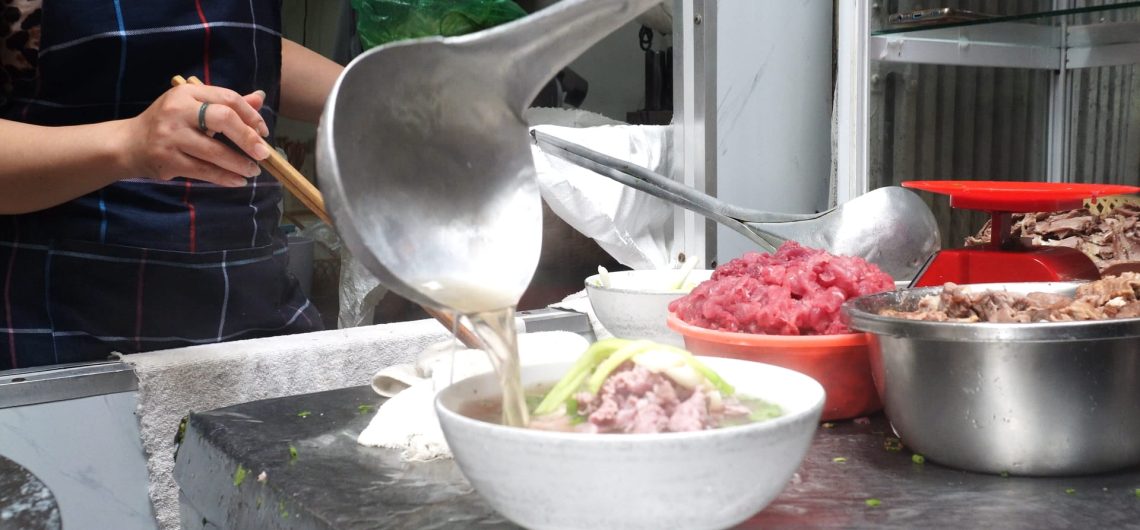Soups in Vietnam — especially in Hanoi — are a journey into the heart of the capital’s most authentic flavors. Hanoi, a vibrant city, is a true culinary paradise where noodle soups play a central role. From steaming bowls of phở bò— fragrant beef rice noodle soup with fresh herbs — the city invites you into a true gastronomic symphony. But where can you find the best soup in Vietnam? Vietnamese noodles, whether phở or bún, differ in texture and how they’re made. Bún noodles are thin and round, made from fermented rice flour, giving them an elastic texture. Phở noodles, on the other hand, are wide and flat, made from fresh rice, and often used in rich soups like phở bò. This variety of flavors and noodle types is a true reflection of Hanoi's culinary culture. Here’s our selection of 10 must-visit spots to discover these delicious dishes and satisfy your appetite! 1. Phở Sướng – Beef Rice Noodle Soup Address: 36B Mai Hắc Đế, Hoàn Kiếm, HanoiOpening Hours: 6:00 AM – 12:00 PM When it comes to soup in Vietnam, phở is king. Phở Sướng is an iconic spot in Hanoi, beloved by locals for its hearty, flavorful phở bò. This small street-side eatery, tucked in a lively alley, invites customers to sit on small plastic stools and enjoy their bowl while watching the city bustle around them. The broth, rich and deep, is simmered for hours with carefully selected beef bones, while the meat is tender and aromatic. Here, every bowl of phở offers not only exquisite flavors but also the soul of Hanoi. Don’t miss the poached egg! It’s a well-kept local secret: a gently cooked egg dropped straight into the steaming broth. Its creamy texture and rich taste add an irresistible layer to the phở
Soups in Vietnam — especially in Hanoi — are a journey into the heart of the capital’s most authentic flavors.
Hanoi, a vibrant city, is a true culinary paradise where noodle soups play a central role. From steaming bowls of phở bò— fragrant beef rice noodle soup with fresh herbs — the city invites you into a true gastronomic symphony. But where can you find the best soup in Vietnam?
Vietnamese noodles, whether phở or bún, differ in texture and how they’re made. Bún noodles are thin and round, made from fermented rice flour, giving them an elastic texture. Phở noodles, on the other hand, are wide and flat, made from fresh rice, and often used in rich soups like phở bò.
This variety of flavors and noodle types is a true reflection of Hanoi‘s culinary culture. Here’s our selection of 10 must-visit spots to discover these delicious dishes and satisfy your appetite!
1. Phở Sướng – Beef Rice Noodle Soup
Address: 36B Mai Hắc Đế, Hoàn Kiếm, Hanoi
Opening Hours: 6:00 AM – 12:00 PM
When it comes to soup in Vietnam, phở is king. Phở Sướng is an iconic spot in Hanoi, beloved by locals for its hearty, flavorful phở bò. This small street-side eatery, tucked in a lively alley, invites customers to sit on small plastic stools and enjoy their bowl while watching the city bustle around them. The broth, rich and deep, is simmered for hours with carefully selected beef bones, while the meat is tender and aromatic. Here, every bowl of phở offers not only exquisite flavors but also the soul of Hanoi.
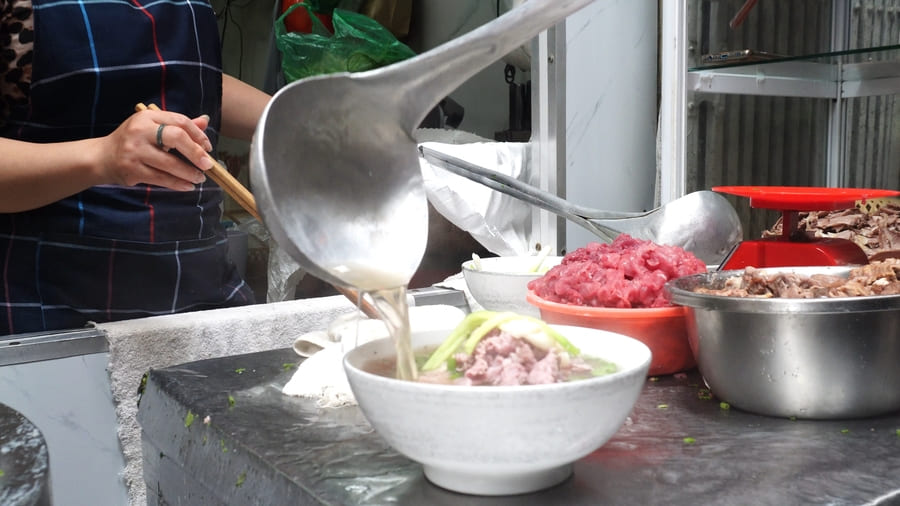
Don’t miss the poached egg! It’s a well-kept local secret: a gently cooked egg dropped straight into the steaming broth. Its creamy texture and rich taste add an irresistible layer to the phở — an unforgettable culinary experience.
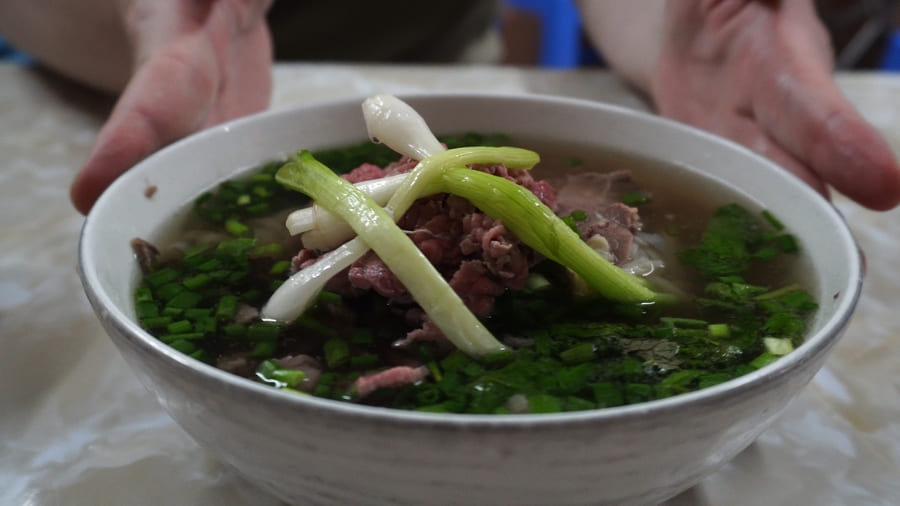
2. Phở Gà Nguyệt – Chicken Rice Noodle Soup
Address: 5B Phủ Doãn Street, Hanoi
Opening Hours: 6:00 AM – 10:00 AM and 5:00 PM – 1:00 AM
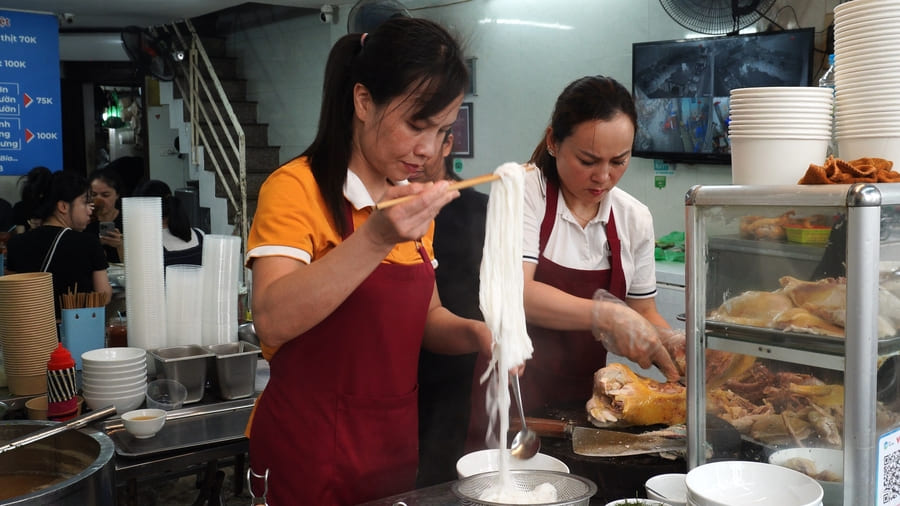
Another iconic Vietnamese soup is chicken phở. This spot, located near Hàng Bông Street and awarded a Michelin Bib Gourmand in 2024, has been attracting phở lovers since 2009. As the name suggests, Phở Gà Nguyệt offers various chicken parts, but the tender thighs and soft breast are the most popular among tourists.
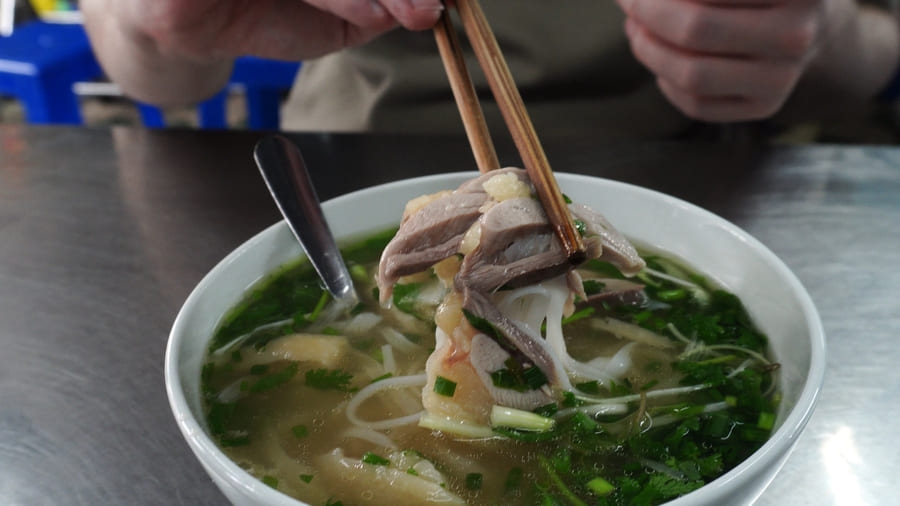
Open all day, the place sees its biggest crowd from 5:00 PM to 12:30 AM — ideal for a late-night meal with friends or a quiet solo bowl in the capital’s authentic ambiance.
3. Phở Hùng Vương – Stone Bowl Phở near Ho Chi Minh Mausoleum
Address: Near the Ho Chi Minh Mausoleum, Hanoi
Opening Hours: 6:00 AM – 9:00 PM
Phở Hùng Vương is one of the best places to try phở bát đá — a unique interactive experience. The broth is served in a hot stone bowl (bát đá), which keeps the soup boiling hot. Diners drop slices of raw beef or chicken into the broth, allowing them to cook slowly while retaining their juicy flavor.
This phở stands out thanks to its rich, fragrant broth made from fresh, natural ingredients. Delicate spices and fresh herbs bring a refreshing contrast to the hot broth — a one-of-a-kind culinary encounter.
4. Bún Riêu – Crab Tomato Soup
Address: 14 Hàng Lược, Hanoi
Opening Hours: 6:00 AM – 2:00 PM
This spot is a must for bún riêu cua lovers — a traditional Hanoi dish made with freshwater crab paste (gạch cua đồng), not sea crab meat. This gives the broth a more delicate flavor and smoother texture. The paste is seasoned and cooked in the broth until it releases all its subtle flavors. The dish combines the acidity of fresh tomatoes with the richness of crab, plus fried tofu and dried shrimp for extra depth.
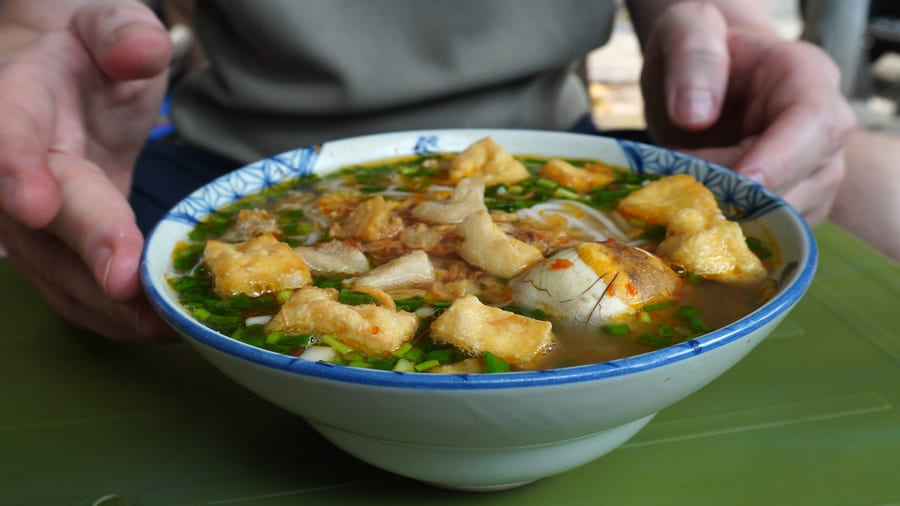
Tucked into a narrow lane in Hanoi’s Old Quarter, the small eatery offers a warm, intimate atmosphere. The scent of hot broth mingling with street life creates a uniquely sensory experience.
5. Bánh Đa Cá – Red Rice Noodle Soup with Fish
Address: Ô Quan Chưởng Street, near the gate
Opening Hours: 5:00 PM – 8:30 PM
Originally from northern Vietnam, bánh đa cá is a traditional soup featuring brown rice noodles (bánh đa), fried fish (often mackerel or catfish), and a light herbal broth. The noodles’ firm texture and the fish’s richness contrast perfectly with the freshness of dill, scallions, and sometimes tamarind.
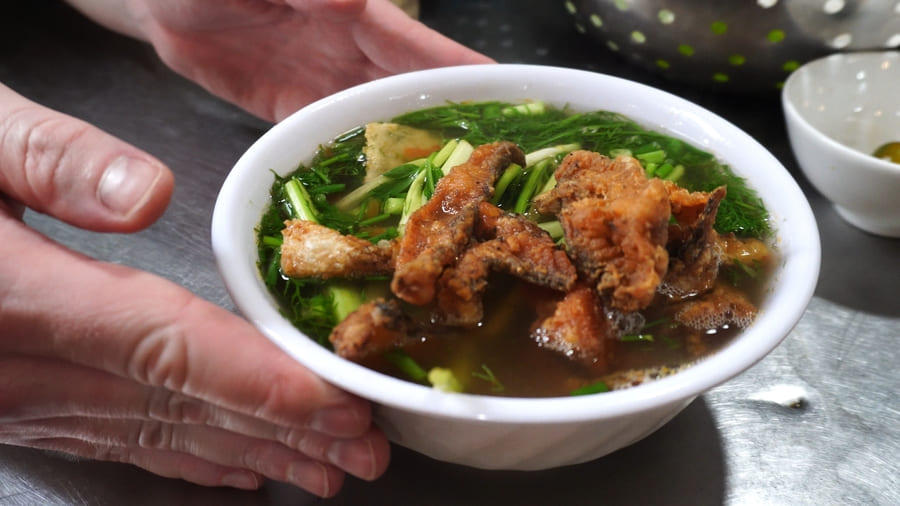
Popular in Hải Phòng, this dish is a perfect example of the Vietnamese flavor balance — sweet, salty, tangy, and umami — and a great choice for breakfast or a light lunch.
6. Bún Ốc Thuý – Snail Noodle Soup
Address: 11 Đồng Xuân, Hoàn Kiếm, Hanoi
Opening Hours: 7:30 AM – 5:30 PM
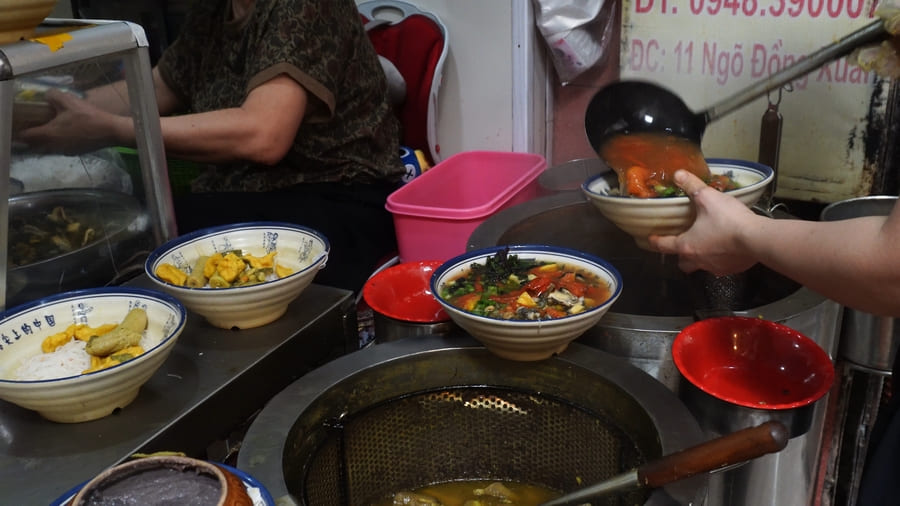
A traditional Hanoi favorite, bún ốc combines sautéed snails, crispy fried tofu, aromatic green banana, and a slightly sour broth. Simple yet deeply satisfying, it evokes childhood memories for many locals. The subtle crab flavor and the mild sourness from fermented rice (mẻ) create a flavor that lingers.
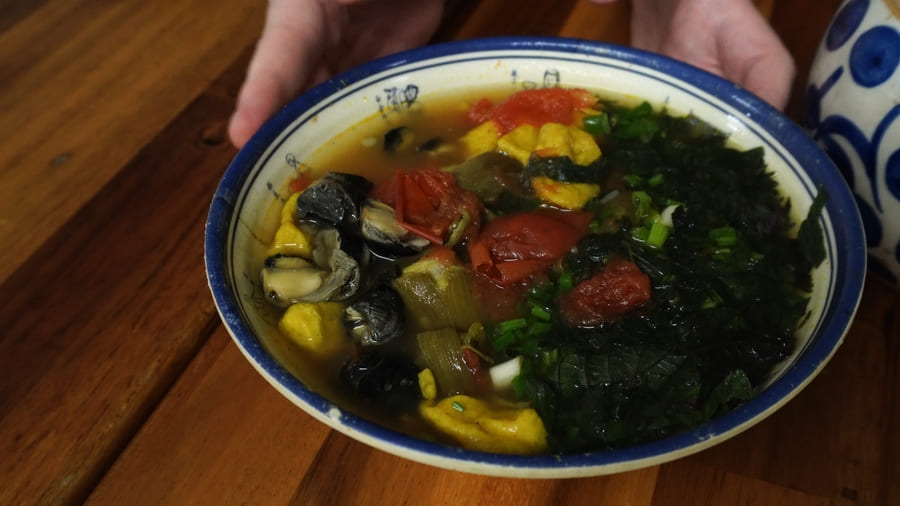
Popular for its spicy, tangy broth and aromatic vinegar notes, this restaurant in the Old Quarter serves generous bowls topped with snails, scallions, fresh tomatoes, and rice noodles. Perfect after exploring Hoàn Kiếm Lake and the busy streets of Hanoi.
7. Bún Thang Bà Tổng – Chicken Noodle Soup
Address: 56 Ngô Sỹ Liên, Hanoi
Opening Hours: 6:30 AM – 8:30 PM
Let’s turn to another noodle variety: bún. In Hanoi, don’t miss bún thang — a refined, nostalgic specialty. This elegant soup combines thin rice noodles with shredded chicken, Vietnamese pork sausage, and omelet strips in a clear, flavorful broth made from chicken, dried shrimp, and shiitake mushrooms. Each ingredient is finely sliced to create a beautiful and balanced bowl.
Traditionally made with Tet leftovers, it’s now freshly prepared in restaurants. At Bún Thang Bà Tổng, you can ask to add mắm tôm (fermented shrimp paste) — a strong but optional flavor enhancer.
8. Bún mọc Thủy – Pork Ball Vermicelli Soup
Address: 10 Đào Duy Từ Alley, Hoàn Kiếm, Hanoi
Opening Hours: 6:30 AM – 1:30 PM
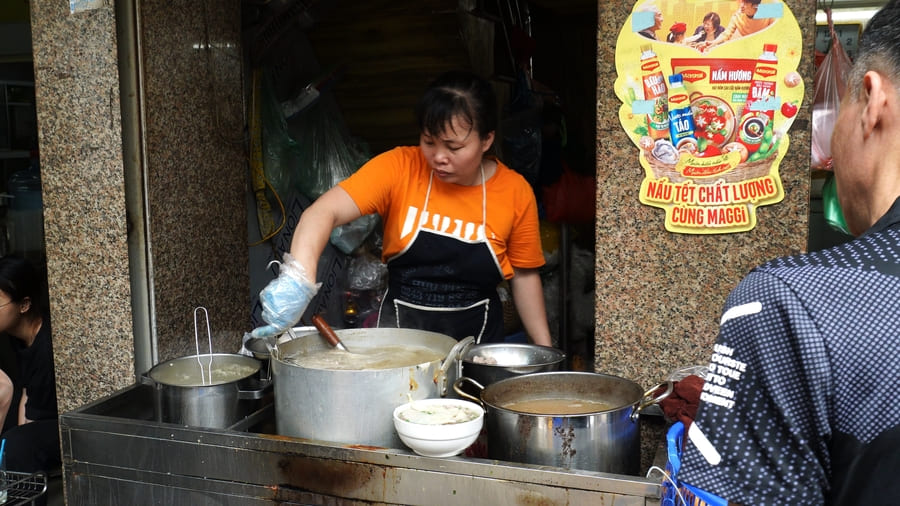
Bún mọc is a beloved Hanoi breakfast dish made with vermicelli noodles and pork meatballs (mọc) mixed with black fungus and shiitake mushrooms. Sometimes bamboo shoots, pork sausage (giò), or pork ribs are added.
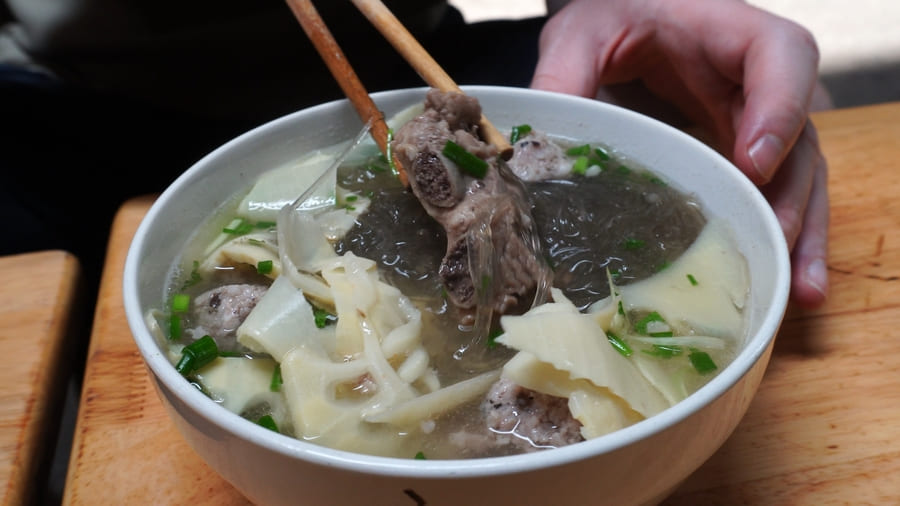
The clear, slightly sweet broth is made from simmered pork bones and served with fresh herbs, chili vinegar, and a pinch of pepper. For an authentic local experience, visit this small stall tucked in an animated alley of Hanoi’s Old Quarter.
9. Miến Lươn – Glass Noodles with Eel at Đông Thịnh
Address: 87 Hàng Điếu, Cửa Đông, Hoàn Kiếm, Hanoi
Opening Hours: 6:30 AM – 10:00 PM
Miến lươn Đông Thịnh is a long-standing Hanoi favorite, specializing in eel and glass noodle dishes. Located on Hàng Điếu Street in the Hoàn Kiếm district, this family-run eatery has been serving customers for over 40 years. In 2024, it was honored with a Michelin Bib Gourmand for its excellent value.
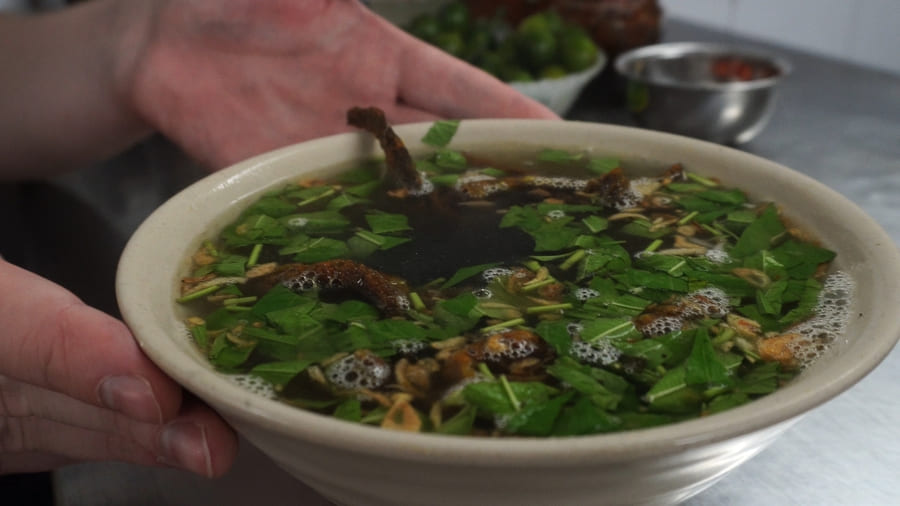
Though modest in appearance, it is known for its cleanliness, warm atmosphere, and consistently flavorful dishes. With prices ranging from 30,000 to 50,000 VND (around €1.20–2), it offers exceptional quality at a low cost.
We’ve just shared some of Hanoi’s best soup in Vietnam and where to enjoy them. To explore even more of the city’s beauty and culture through its authentic cuisine, book our food tour today. Thank you — and see you soon in Hanoi!





















